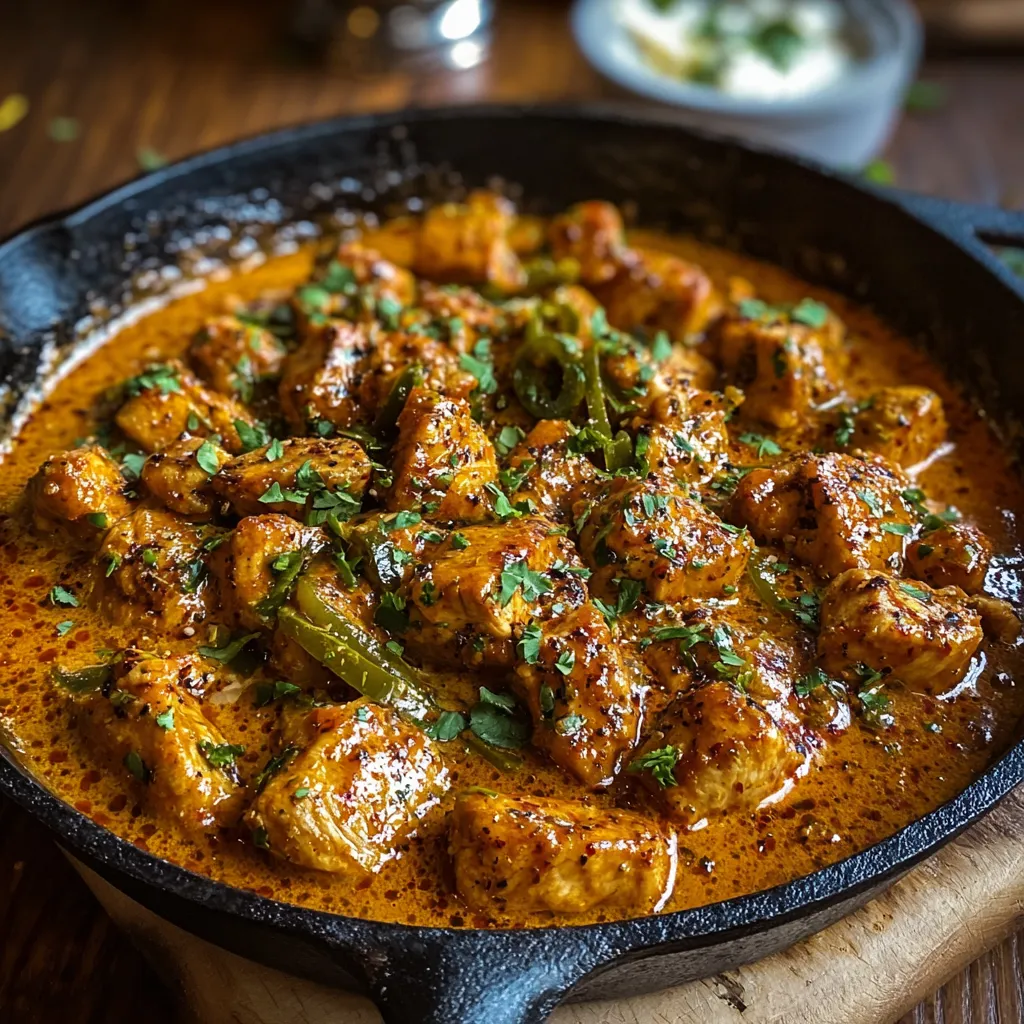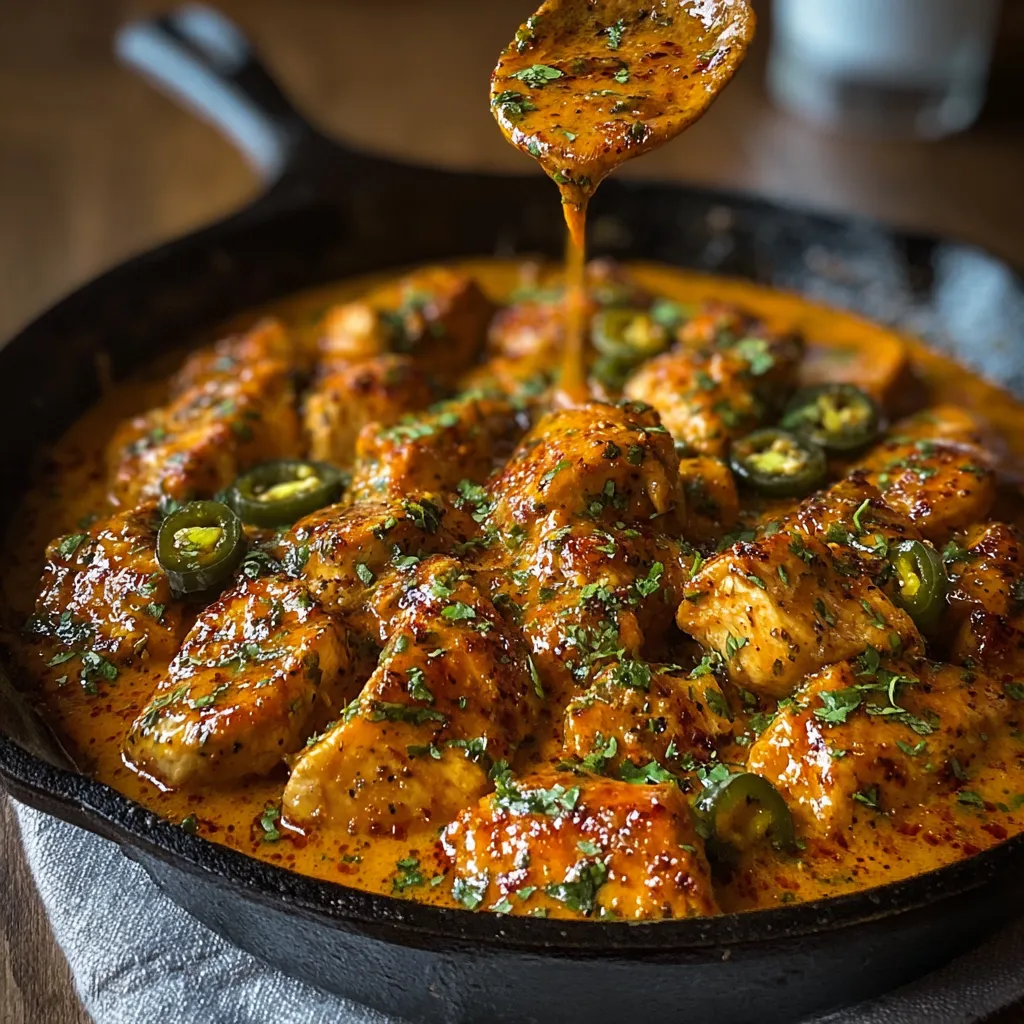Unlocking the Secret Sauce: The Science Behind the Skillet
The key to a truly exceptional Butter Chicken Skillet lies in understanding the science behind each component. First, and perhaps most critically, is the butter chicken sauce itself. Traditional butter chicken, often found in Indian cuisine (Butter Chicken), relies on a rich tomato-based gravy, heavily infused with butter (hence the name), cream, and a carefully balanced blend of spices. The spices are usually bloomed in hot oil or ghee to release their aromatic compounds, creating a deeper, more complex flavor profile. This blooming process is crucial; it transforms the raw, sometimes harsh notes of the spices into a mellow, fragrant symphony. The second scientific principle at play is the Maillard reaction, which occurs when amino acids and reducing sugars are heated. This reaction is responsible for the browning of the chicken and vegetables, and it’s what gives them that irresistible savory flavor. A hot skillet and a little bit of patience are all you need to encourage this reaction. Finally, understanding the role of acidity is essential. Tomatoes, a key ingredient in the sauce, contribute acidity, which balances the richness of the butter and cream. A touch of lemon juice or vinegar can also be used to enhance this effect and brighten the overall flavor. The interplay of fat, acid, and spice is what makes butter chicken so addictive. We also see this combination of flavors in Hot Honey Feta Chicken.The Recipe: Texas Roadhouse Butter Chicken Skillet (Inspired)
 Here’s my take on a Texas Roadhouse-inspired Butter Chicken Skillet recipe, designed to be both flavorful and relatively easy to make at home:
Here’s my take on a Texas Roadhouse-inspired Butter Chicken Skillet recipe, designed to be both flavorful and relatively easy to make at home:
Ingredients:
- For the Chicken:
- 1.5 lbs boneless, skinless chicken breasts, cut into 1-inch cubes
- 1 tbsp olive oil
- 1 tsp smoked paprika
- 1/2 tsp garlic powder
- 1/4 tsp cayenne pepper (optional, for heat)
- Salt and black pepper to taste
- For the Butter Chicken Sauce:
- 4 tbsp butter
- 1 medium onion, finely chopped
- 2 cloves garlic, minced
- 1 inch ginger, grated
- 1 (14.5 oz) can diced tomatoes, undrained
- 1 (6 oz) can tomato paste
- 1 cup heavy cream
- 1/2 cup chicken broth
- 1 tbsp garam masala
- 1 tsp turmeric powder
- 1/2 tsp cumin powder
- 1/4 tsp chili powder
- 1/4 cup chopped cilantro, for garnish
- Juice of 1/2 lemon
- Salt and sugar to taste
- For the Skillet:
- 1 tbsp olive oil
- 1 red bell pepper, sliced
- 1 green bell pepper, sliced
- 1 yellow bell pepper, sliced
- 1/2 red onion, sliced
Instructions:
- Prepare the Chicken: In a bowl, toss the chicken cubes with olive oil, smoked paprika, garlic powder, cayenne pepper (if using), salt, and black pepper. Ensure the chicken is evenly coated.
- Sear the Chicken: Heat 1 tablespoon of olive oil in a large skillet over medium-high heat. Add the chicken and cook until browned on all sides and cooked through (about 6-8 minutes). Remove the chicken from the skillet and set aside.
- Sauté the Vegetables: In the same skillet, add another 1 tablespoon of olive oil. Add the sliced bell peppers and red onion. Sauté until they are tender-crisp, about 5-7 minutes. Remove the vegetables from the skillet and set aside.
- Make the Butter Chicken Sauce: In the same skillet, melt the butter over medium heat. Add the chopped onion and cook until softened, about 5 minutes. Add the minced garlic and grated ginger and cook for another minute until fragrant. Be careful not to burn the garlic.
- Bloom the Spices: Add the garam masala, turmeric powder, cumin powder, and chili powder to the skillet. Cook for about 30 seconds, stirring constantly, until fragrant. This step is crucial for releasing the flavors of the spices.
- Simmer the Sauce: Add the diced tomatoes (undrained) and tomato paste to the skillet. Stir to combine. Add the chicken broth and bring the mixture to a simmer. Reduce the heat and simmer for 15-20 minutes, stirring occasionally, until the sauce has thickened slightly.
- Finish the Sauce: Stir in the heavy cream and lemon juice. Season with salt and a pinch of sugar to taste. The sugar helps to balance the acidity of the tomatoes.
- Combine and Serve: Return the cooked chicken and vegetables to the skillet. Stir to coat them evenly with the butter chicken sauce. Heat through for a few minutes. Garnish with chopped cilantro before serving. Serve hot with naan bread or rice.
The Investigation: My Quest for Butter Chicken Skillet Perfection
The Initial Disaster Zone
My first few attempts at recreating a Texas Roadhouse-worthy Butter Chicken Skillet were, to put it mildly, a disaster. I rushed the process, didn’t pay close enough attention to the spice blooming, and ended up with a bland, watery sauce that tasted nothing like the rich, flavorful version I was aiming for. The chicken was either overcooked or undercooked, the vegetables were mushy, and the overall dish lacked that certain “je ne sais quoi” that makes restaurant food so appealing. I even considered throwing in the towel and ordering takeout! I didn’t have any luck with the first batch of Ground Turkey And Zucchini Skillet either.The Blooming Revelation
Then, I had an “Aha!” moment. I realized I was completely underestimating the importance of blooming the spices. In my early attempts, I simply threw the spices into the sauce without giving them a chance to release their full flavor potential. So, I decided to experiment. I heated the spices in butter for a longer period, stirring constantly, until they became intensely fragrant. The difference was remarkable. The sauce instantly became more complex and aromatic, with a depth of flavor that I hadn’t achieved before.The Cream Conundrum
Another challenge was getting the right consistency for the sauce. The first few times, the sauce was either too thin or too thick. I tried different ratios of heavy cream and chicken broth, but nothing seemed to work. Then, I realized that the key was to simmer the sauce for a longer period, allowing it to reduce and thicken naturally. This also helped to meld the flavors together and create a smoother, more cohesive sauce.The Skillet Strategy
The vegetables also proved to be a tricky element. I wanted them to be tender-crisp, not mushy. I experimented with different cooking times and found that the best approach was to sauté them over high heat for a relatively short period, just until they were slightly softened but still retained their crunch. I also learned that using a variety of colorful bell peppers not only added visual appeal but also contributed to the overall flavor profile. It’s much like when I make my Southwest Skillet.The Final Flourish
Finally, I realized that a touch of acidity was essential to balance the richness of the butter and cream. A squeeze of lemon juice at the end of cooking brightened the flavors and added a refreshing tang. And, of course, a generous garnish of fresh cilantro provided a final burst of freshness and visual appeal. This recipe ended up being just as involved as Chicken Thighs Dinner Recipe.The Technique: Your Foolproof Guide to Butter Chicken Skillet Success
Here’s a summary of the foolproof method, based on my extensive experimentation:- Bloom Your Spices: Don’t skip this step! Heating the spices in butter for a few seconds until fragrant is crucial for unlocking their full flavor potential.
- Simmer, Simmer, Simmer: Allow the sauce to simmer for at least 15-20 minutes to allow it to thicken and the flavors to meld together.
- Tender-Crisp Veggies: Sauté the vegetables over high heat for a short period to ensure they are tender-crisp, not mushy.
- Acidity is Key: A squeeze of lemon juice at the end of cooking will brighten the flavors and balance the richness of the sauce. Similar to the steps to making Garlic Butter Chicken And Veggies.
- Don’t Be Afraid to Adjust: Taste the sauce and adjust the seasoning as needed. Add more salt, sugar, or lemon juice to achieve the perfect balance of flavors.
Why is it important to bloom the spices when making the Butter Chicken Sauce?
Blooming the spices in hot butter releases their aromatic compounds, transforming their raw notes into a mellow, fragrant symphony and creating a deeper, more complex flavor profile in the sauce.
What is the Maillard reaction, and why is it important for this recipe?
The Maillard reaction occurs when amino acids and reducing sugars are heated, resulting in the browning of the chicken and vegetables. This browning is what gives them that irresistible savory flavor.
How do you achieve tender-crisp vegetables in the skillet?
Sauté the vegetables over high heat for a relatively short period, just until they are slightly softened but still retain their crunch.
What’s the purpose of adding lemon juice to the Butter Chicken Skillet at the end of cooking?
Adding a squeeze of lemon juice at the end of cooking brightens the flavors and balances the richness of the butter and cream in the sauce.

Texas Roadhouse Butter Chicken Skillet
Ingredients
Equipment
Method
- Prepare the Chicken: In a bowl, toss the chicken cubes with 1 tablespoon olive oil, smoked paprika, garlic powder, cayenne pepper (if using), salt, and black pepper. Ensure the chicken is evenly coated.
- Sear the Chicken: Heat 1 tablespoon of olive oil in a large skillet over medium-high heat. Add the chicken and cook until browned on all sides and cooked through (about 6-8 minutes). Remove the chicken from the skillet and set aside.
- Sauté the Vegetables: In the same skillet, add another 1 tablespoon of olive oil. Add the sliced bell peppers and red onion. Sauté until they are tender-crisp, about 5-7 minutes. Remove the vegetables from the skillet and set aside.
- Make the Butter Chicken Sauce: In the same skillet, melt the butter over medium heat. Add the chopped onion and cook until softened, about 5 minutes. Add the minced garlic and grated ginger and cook for another minute until fragrant. Be careful not to burn the garlic.
- Bloom the Spices: Add the garam masala, turmeric powder, cumin powder, and chili powder to the skillet. Cook for about 30 seconds, stirring constantly, until fragrant. This step is crucial for releasing the flavors of the spices.
- Simmer the Sauce: Add the diced tomatoes (undrained) and tomato paste to the skillet. Stir to combine. Add the chicken broth and bring the mixture to a simmer. Reduce the heat and simmer for 15-20 minutes, stirring occasionally, until the sauce has thickened slightly.
- Finish the Sauce: Stir in the heavy cream and lemon juice. Season with salt and a pinch of sugar to taste. The sugar helps to balance the acidity of the tomatoes.
- Combine and Serve: Return the cooked chicken and vegetables to the skillet. Stir to coat them evenly with the butter chicken sauce. Heat through for a few minutes. Garnish with chopped cilantro before serving. Serve hot with naan bread or rice.

